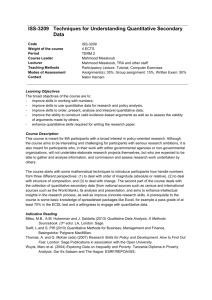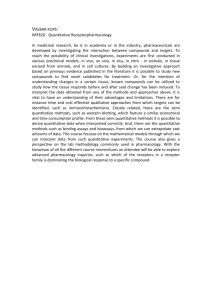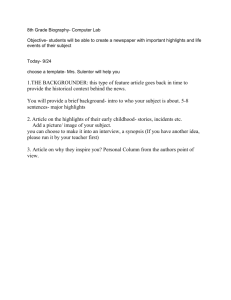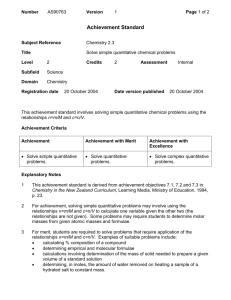Rubric for Presentations, by Susanmarie Harrington
advertisement
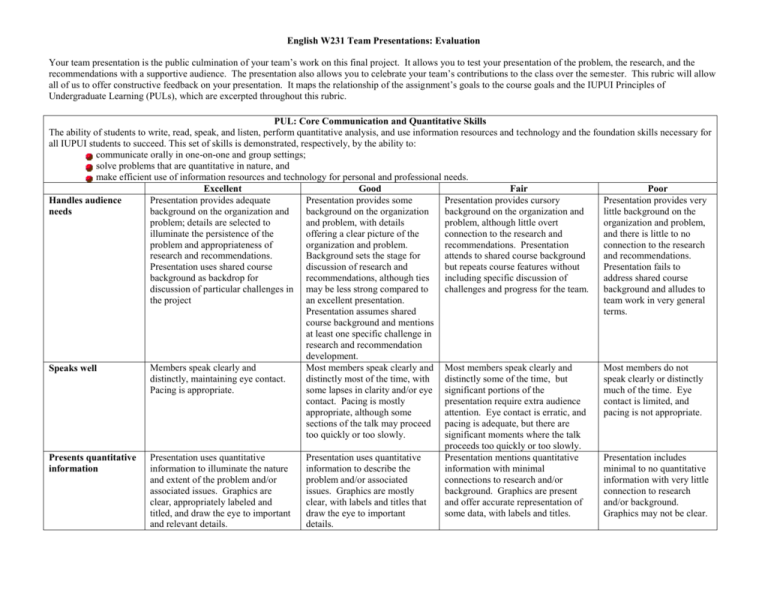
English W231 Team Presentations: Evaluation Your team presentation is the public culmination of your team’s work on this final project. It allows you to test your presentation of the problem, the research, and the recommendations with a supportive audience. The presentation also allows you to celebrate your team’s contributions to the class over the semester. This rubric will allow all of us to offer constructive feedback on your presentation. It maps the relationship of the assignment’s goals to the course goals and the IUPUI Principles of Undergraduate Learning (PULs), which are excerpted throughout this rubric. PUL: Core Communication and Quantitative Skills The ability of students to write, read, speak, and listen, perform quantitative analysis, and use information resources and technology and the foundation skills necessary for all IUPUI students to succeed. This set of skills is demonstrated, respectively, by the ability to: communicate orally in one-on-one and group settings; solve problems that are quantitative in nature, and make efficient use of information resources and technology for personal and professional needs. Excellent Good Fair Poor Presentation provides adequate Presentation provides some Presentation provides cursory Presentation provides very Handles audience background on the organization and background on the organization background on the organization and little background on the needs problem; details are selected to and problem, with details problem, although little overt organization and problem, illuminate the persistence of the offering a clear picture of the connection to the research and and there is little to no problem and appropriateness of organization and problem. recommendations. Presentation connection to the research research and recommendations. Background sets the stage for attends to shared course background and recommendations. Presentation uses shared course discussion of research and but repeats course features without Presentation fails to background as backdrop for recommendations, although ties including specific discussion of address shared course discussion of particular challenges in may be less strong compared to challenges and progress for the team. background and alludes to the project an excellent presentation. team work in very general Presentation assumes shared terms. course background and mentions at least one specific challenge in research and recommendation development. Members speak clearly and Most members speak clearly and Most members speak clearly and Most members do not Speaks well distinctly, maintaining eye contact. distinctly most of the time, with distinctly some of the time, but speak clearly or distinctly Pacing is appropriate. some lapses in clarity and/or eye significant portions of the much of the time. Eye contact. Pacing is mostly presentation require extra audience contact is limited, and appropriate, although some attention. Eye contact is erratic, and pacing is not appropriate. sections of the talk may proceed pacing is adequate, but there are too quickly or too slowly. significant moments where the talk proceeds too quickly or too slowly. Presentation uses quantitative Presentation mentions quantitative Presentation includes Presents quantitative Presentation uses quantitative information to illuminate the nature information to describe the information with minimal minimal to no quantitative information and extent of the problem and/or problem and/or associated connections to research and/or information with very little associated issues. Graphics are issues. Graphics are mostly background. Graphics are present connection to research clear, appropriately labeled and clear, with labels and titles that and offer accurate representation of and/or background. titled, and draw the eye to important draw the eye to important some data, with labels and titles. Graphics may not be clear. and relevant details. details. Uses Technology Effectively Use of time Excellent Presentation uses clear slides, with appropriate contrast, highlights, and parallelism. The language of the presentation is clear, indicating command of the issues and ability to communicate with nonspecialists. Good Presentation uses clear slides, with some contrast, highlights, and parallelism. The language of the presentation is mostly clear, indicating understanding of the issues and basic ability to with non-specialists. Presentation uses the allotted ten-fifteen minutes for presentation. Team members encourage discussion and questions. Presentation comes close to the allotted ten-fifteen minutes. Team members welcome discussion and questions but do not encourage them. Fair Presentation uses slides, with uneven quality of contrast, highlights, and parallelism. The language of the presentation is often, but not always, clear. Presentation indicates basic, but sometimes shaky, grasp of the issues and an uneven ability to communicate with nonspecialists. Presentation goes significantly over or under the allotted tenfifteen minutes. Team members do not mind discussion or questions but do not overly encourage them. Poor Presentation may lack slides, or may use slides of poor quality, with little contrast, highlights, or parallelism. The language of the presentation is often unclear. Presentation does not indicate a basic grasp of the issues or ability to communicate with non-specialists. ten-fifteen PUL: Critical Thinking The ability of students to analyze information and ideas carefully and logically from multiple perspectives. This skill is demonstrated by the ability of students to: analyze complex issues and make informed decisions; synthesize information in order to arrive at reasoned conclusions; evaluate the logic, validity, and relevance of data; solve challenging problems, and; use knowledge and understanding in order to generate and explore new questions. PUL: Values and Ethics The ability of students to make judgments with respect to individual conduct, citizenship, and aesthetics. A sense of values and ethics is demonstrated by the ability of students to: make informed and principled choices regarding conflicting situations in their personal and public lives and to foresee the consequences of these choices Presentation highlights relevant Presentation highlights primary Presentation discusses primary Presentation may fail to discuss Synthesizes and applies portions of quality primary and and secondary research, offering and secondary research, but both primary and secondary research secondary research. Informed mostly consistent quality and quality and relevance has research, or may discuss recommendations are clearly relevance. A small portion of the noticeable lapses. A section of research only perfunctorily. The tied to quality research. A presentation seems unfocused, the presentation seems presentation does not seem strong theme unifies the although a good theme runs unfocused, although a theme is focused on a main theme. presentation. throughout the presentation. recognizable. Partly informed Recommendations are not Informed recommendations are recommendations have weak connected to research and thus mostly tied to good research. ties to research. do not appear informed. Understanding Society and Culture The ability of students to recognize their own cultural traditions and to understand and appreciate the diversity of the human experience, both within the United States and internationally. This skill is demonstrated by the ability to: compare and contrast the range of diversity and universality in human history, societies, and ways of life; analyze and understand the interconnectedness of global and local concerns, and; operate with civility in a complex social world. recognize the importance of aesthetics in their personal lives and to society. Excellent Good Fair Poor Presentation uses tactful, Presentation uses mostly Presentation uses complaintPresentation largely fails to use Uses appropriate organization-centered language organization-centered language centered language in key places organization-centered language. language to describe the organizational to describe the problem. to describe the organizational Recommendations may not be problem. Recommendations Recommendations recognize the problem. Recommendations are sound, and may not be tied to explicitly recognize the human human complexities associated sound but do not recognize the the organization’s mission. complexities associated with with implementing change, human complexities associated implementing change. although not as consistently as with implementing change. an excellent presentation.



